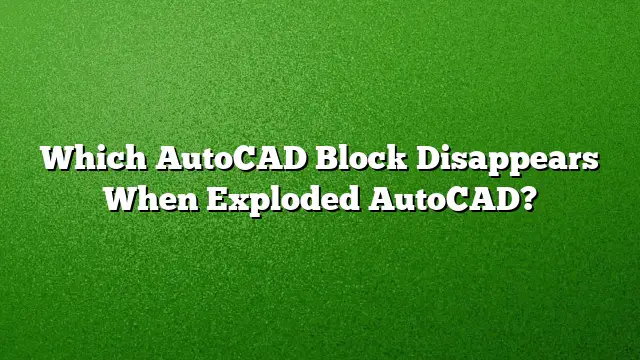Understanding Block Disappearance in AutoCAD
When working with AutoCAD, users might encounter situations where exploding a block results in the block disappearing entirely from the drawing. This can be frustrating, but several reasons and solutions can clarify why this happens.
Reasons for Disappearance Upon Exploding
-
Layer Status: One of the common reasons a block disappears after being exploded is if the layer the block resides on is turned OFF or FROZEN. Blocks on these layers will not display, leading to confusion about their existence in the drawing.
-
Visibility Parameters: Sometimes, blocks might contain visibility parameters that control what is visible when the block is inserted. If these parameters are not properly managed, parts of the block might not show up after an explosion.
- Nested Blocks: If the block you are trying to explode contains nested blocks, exploding it may expose these other blocks that could be on layers that are turned off or frozen, causing them to vanish from view.
Steps to Prevent Blocks from Disappearing
-
Check Layer Status:
- Open the Layer Properties Manager.
- Ensure that the layer with the block is ON and not FROZEN or LOCKED.
-
Edit the Block:
- Use the Block Editor to open the block.
- Remove any unnecessary visibility parameters or extra definitions that may cause issues.
- Save the changes before exiting the Block Editor.
- Use QSELECT Command:
- Access the QSELECT command to identify any parameters within the block that could affect visibility.
- Select “All” from the Object Type drop-down and review any hidden attributes or parameters.
Exploding a Block Without Issues
To successfully explode a block and retain its attributes:
- Navigate to the Drafting tab.
- Click on the Modify panel and select the Explode option. Alternatively, type the command “X” for a shortcut.
- Carefully select the block to explode and ensure that attributes are set to retain their values.
Restoring Exploded Blocks
If a block disappears after an explosion, check to see if it can be restored:
- Utilize the Undo command if the action was recent.
- Check the command history for any errors or warnings that might indicate issues.
- Re-insert the block if it does not appear to be recoverable. Access the block library and re-add the initial block.
Additional Tips for Managing Blocks
-
Burst Command:
If retaining attribute values is crucial, consider using the BURST command, which allows blocks with attributes to be exploded without losing their assigned values. -
Block Editor Options:
While in the Block Editor, you can allow exploding by selecting the correct options in the Properties palette, ensuring blocks can be modified later without issues. - Regularly Save Drawings:
Regularly saving your work can prevent data loss during block modifications and explosions.
FAQ
1. What is the effect of exploding nested blocks?
Exploding nested blocks reveals the individual components that make up the nested block, which may also require further exploding if they contain additional nested elements.
2. How can I find a missing block after exploding?
You can locate a missing block by using the Command prompt. Type “BLOCK” to access the block list and check if it still exists in the drawing or needs to be reinserted from the library.
3. What happens when I explode a block with attributes?
When you explode a block with attributes using the regular Explode command, the attributes may lose their assigned values. To retain these values, use the BURST command instead.

